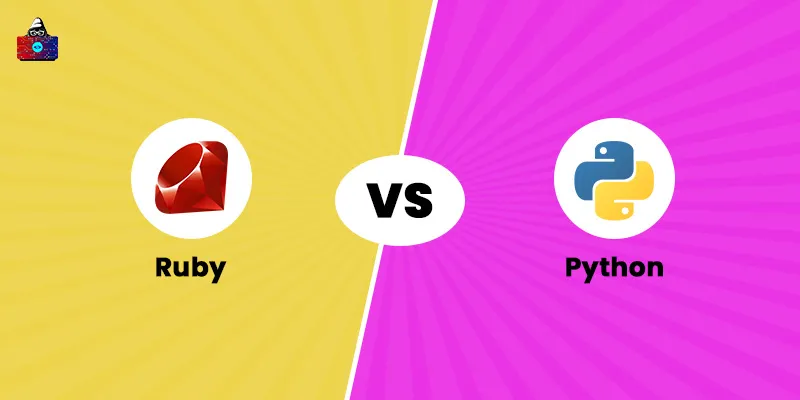Ruby is an interpreted, high-level programming language. It is a general-purpose language that supports various programming paradigms , such as object-oriented, functional, and imperative. It primarily focuses on the productivity and simplicity of programming.
If you have ever been in web development, you might have definitely heard about the Ruby on Rails framework, a full-stack web development framework. And Ruby has gained massive popularity from this framework. Not only does Ruby has its applications in web development, but also it is used in developing various projects as it is a general-purpose language.
In this article, we will present some popular real-world applications of Ruby. Also, we shall briefly introduce you to what Ruby is and why it is popular.
So, let us begin our discussion!
What is Ruby?
Developed by Yukihiro "Matz" Matsumoto in the middle of the 1990s, Ruby is an object-oriented language. This dynamic language has an elegant syntax that makes it easy for novices to read, learn, and write. Basically, it is a server-side scripting language that includes the best features of other programming languages, such as Python , Perl, LISP, Eiffel, Ada, and Smalltalk.
Ruby is a dynamically-typed language that leverages just-in-time compilation and garbage collection. You will find everything as an object, along with primitive data types in Ruby. The syntax is analogous to C and Java. So, if you are already familiar with C or Java, learning Ruby will be simple and quick.
Moreover, the language can easily embed into HTML tags, is used for writing Common Gateway Interface (CGI) scripts, and comes with a wide range of built-in functions that you can use in your Ruby scripts.
Though Ruby entered the market of programming languages in 1995, it did not gain any attention until 2006. Later, the language became a center of attraction among developers worldwide because of the advent of Ruby on Rails. This full-stack web framework transformed the way web applications were developed earlier. It makes it possible for developers to produce web apps more quickly.
Features of Ruby
Let us now shed light on the remarkable features of Ruby to gain a better understanding of the language.

- Object-Oriented: It is an object-oriented programming language, and everything, including primitive data types, is treated as objects.
- Dynamic Typing: As Ruby is a dynamically-typed language, the interpreter assigns the data type of variables during runtime depending on their values.
- Inbuilt Libraries: The language comes with an array of inbuilt libraries that facilitate the web development process.
- Automatic Garbage Collector: The language automatically manages memory without the need for programmers. They do not have to specify which objects to be freed and which not manually.
- Platform-Independent Language: Being a platform-independent language, you can run Ruby programs on different platforms, such as Linux, Windows, Unix, etc.
- Duck Typing: It is a concept that does not primarily focus on the object of a class. Instead, it is more concerned about the methods of a class and operations to be performed on those methods.
Advantages and Disadvantages of Ruby

Here are a few major benefits and significant drawbacks of Ruby:
Advantages
- The language has a clean and elegant syntax that makes it easy for beginners to learn. So, it has a shallow learning curve.
- Ruby code involves a smaller number of lines, making it small and easy to write.
- With minimal effort, the language lets you create web applications in less time.
- Being an open-source language, you can modify its source code to meet your requirements.
- As it is a dynamic language, there are no tough rules on implementing its features.
Disadvantages
- It becomes pretty tough to debug Ruby code.
- There are not plenty of resources available for Ruby as compared to other languages.
- Since it is an interpreted language, it is slower than compiled languages.
What is Ruby Used For?
Now, let us move on to discussing the real-world applications of Ruby.

-
Web Development
Ruby’s popularity began among developers after the inception of Ruby on Rails. This framework was released in the market in 2006, and since then, the approach to web development has been completely revolutionized.
Before the advent of this framework, developers required a lot of time to write code. The framework comes with all the features that facilitate web development and assist developers by eliminating the need to code everything from scratch. It features code generators that create code for your application’s part with just a simple command. As a result, developers have to take minimal effort in writing code.
Moreover, Ruby on Rails makes use of standard conventions that specify the structure of every Rails app. As a result, configuring apps takes less time for developers.
The framework makes rapid development possible. This feature has forced various small as well as large organizations to adopt it to develop large applications. GitHub, Shopify, ZenDesk, Hulu, Twitch, and SoundCloud are a few popular websites developed using Ruby on Rails.
-
DevOps and Automation
Along with website development, Ruby is also popular in DevOps and automation. A popular web deployment platform called Heroku originally only supported Ruby, though it supports a variety of languages today. This platform makes it easy for novices to deploy applications with ease, even if they do not possess knowledge of DevOps.
Moreover, this platform gained traction among startups as it allowed them to code, test, and deploy their applications without the need for a dedicated DevOps engineer.
Another popular tool developed in Ruby is Vagrant. This tool allows users to manage virtual machines from the command line. With Vagrant, you can code and run an application developed for a specific operating system on any other operating system. For example, you can build and run services, only intended for Linux, on Windows and macOS and be sure that they run correctly after deployment.
-
Static Site Generation
Static generation is basically the process of compiling and rendering a specific website or application at its build time. The output we get is a set of static files, out of which there is an HTML file.
A web server sends a plain HTML page with little content, which is what a browser receives. Next comes the hydration process, which involves loading content onto the page.
Tools, like Next.js, try to render a website that appears close to what it would look like in a browser but at compile time, with static generation. This becomes possible to serve the entire content on the first load. This implies that websites using static generators produce all of their pages at once. All these pages are deployed to a server. When you visit that website’s URL, you will receive a static HTML file.
When you develop websites with static site generators, they are fast, easy to deploy, and secure. The first static site generator, called Jekyll, was developed in Ruby, which is still one of the most popular tools.
-
Data Processing
Data processing is a process of transforming collected raw data into a usable form. It involves data collection and manipulation by computer systems. Ruby comes with built-in functions, such as reduce, map, and select, that come in handy for data processing. So, we can leverage Ruby for data processing, cleaning, and filtering.
-
Web Scraping and Crawling
Web scraping is a technique for extracting very large amounts of data from websites automatically. Ruby comes with a vast set of built-in packages that make web scraping a breeze.
On the flip side, web crawling is the process that makes use of automated scripts to index data on web pages. A Ruby library called Vessel lets you crawl and download web pages. There is another library called Nokogiri . Developers find this library handy when it comes to dealing with XML and HTML from Ruby. The primary purpose of this library is to parse the HTML of crawled web pages and derive specific portions of web pages structurally so that it becomes easy for data analysis .
-
Web Servers
Last but not least, Ruby is popularly employed to create web servers . Unicorn, Puma, and Passenger are a few web servers powered by Ruby. These web servers accept raw HTTP requests, transmit them to the appropriate back-end applications, and manage the response back from the applications. Web application servers developed in Ruby work well with Ruby frameworks.
Conclusion
This ends our discussion on what Ruby is used for. Though developed in the middle of the 1990s, it was not so popular until the advent of Ruby on Rails in 2006. As developers started loving the Ruby on Rails framework, they started to know more about the Ruby language.
Today, the language is popular and in demand. You can use it for website development, building static site generators, creating web servers, web scraping and crawling, data processing, and DevOps and automation.
Hopefully, this article might have been helpful to you in understanding the real-world applications of Ruby.
People are also reading:



Leave a Comment on this Post